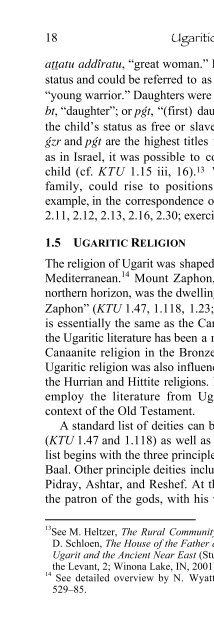A Primer on Ugaritic: Language, Culture, and Literature - enenuru
A Primer on Ugaritic: Language, Culture, and Literature - enenuru
A Primer on Ugaritic: Language, Culture, and Literature - enenuru
You also want an ePaper? Increase the reach of your titles
YUMPU automatically turns print PDFs into web optimized ePapers that Google loves.
18<br />
<strong>Ugaritic</strong> <str<strong>on</strong>g>Primer</str<strong>on</strong>g><br />
attatu addiîratu, “great woman.” Likewise, s<strong>on</strong>s were not of equal<br />
status <strong>and</strong> could be referred to as n{r, “servant”; bn, “s<strong>on</strong>”; or gízr,<br />
“young warrior.” Daughters were socially ranked as n{rt, “servant”;<br />
bt, “daughter”; or pgít, “(first) daughter.” These designati<strong>on</strong>s reflect<br />
the child’s status as free or slave <strong>and</strong> their inheritance. The titles<br />
gízr <strong>and</strong> pgít are the highest titles for a s<strong>on</strong> <strong>and</strong> daughter. In Ugarit,<br />
as in Israel, it was possible to c<strong>on</strong>fer the birthright <strong>on</strong> a younger<br />
child (cf. KTU 1.15 iii, 16). 13 Women, especially in the royal<br />
family, could rise to positi<strong>on</strong>s of prominence as we see, for<br />
example, in the corresp<strong>on</strong>dence of the Ugaritian queens (e.g., KTU<br />
2.11, 2.12, 2.13, 2.16, 2.30; exercises §§3.4, 3.5, 3.6, 3.8, 3.9).<br />
1.5 UGARITIC RELIGION<br />
The religi<strong>on</strong> of Ugarit was shaped especially by its locati<strong>on</strong> <strong>on</strong> the<br />
Mediterranean. 14 Mount Zaph<strong>on</strong>, which rose majestically <strong>on</strong> the<br />
northern horiz<strong>on</strong>, was the dwelling place of the il spn, “the gods of<br />
Zaph<strong>on</strong>” (KTU 1.47, 1.118, 1.23; see exercise §6.7). The panthe<strong>on</strong><br />
is essentially the same as the Canaanite panthe<strong>on</strong> <strong>and</strong>, as a result,<br />
the <strong>Ugaritic</strong> literature has been a main source for underst<strong>and</strong>ing the<br />
Canaanite religi<strong>on</strong> in the Br<strong>on</strong>ze <strong>and</strong> Ir<strong>on</strong> Ages. To be sure, the<br />
<strong>Ugaritic</strong> religi<strong>on</strong> was also influenced by its close associati<strong>on</strong> with<br />
the Hurrian <strong>and</strong> Hittite religi<strong>on</strong>s. Nevertheless, careful scholars can<br />
employ the literature from Ugarit to underst<strong>and</strong> the religious<br />
c<strong>on</strong>text of the Old Testament.<br />
A st<strong>and</strong>ard list of deities can be created from two <strong>Ugaritic</strong> texts<br />
(KTU 1.47 <strong>and</strong> 1.118) as well as an Akkadian list (RS 20.24). The<br />
list begins with the three principle deities of Ugarit: El, Dagan, <strong>and</strong><br />
Baal. Other principle deities include Anat, Athirat, Yamm, Kothar,<br />
Pidray, Ashtar, <strong>and</strong> Reshef. At the head of the Panthe<strong>on</strong> was El,<br />
the patr<strong>on</strong> of the gods, with his wife Athirat. El was ruler of the<br />
13<br />
See M. Heltzer, The Rural Community of Ancient Ugarit (Wiesbaden, 1976);<br />
D. Schloen, The House of the Father as Fact <strong>and</strong> Symbol: Patrim<strong>on</strong>ialism in<br />
Ugarit <strong>and</strong> the Ancient Near East (Studies in the Archaeology <strong>and</strong> History of<br />
the Levant, 2; Win<strong>on</strong>a Lake, IN, 2001).<br />
14<br />
See detailed overview by N. Wyatt, “The Religi<strong>on</strong> of Ugarit,” in HUS,<br />
529–85.


